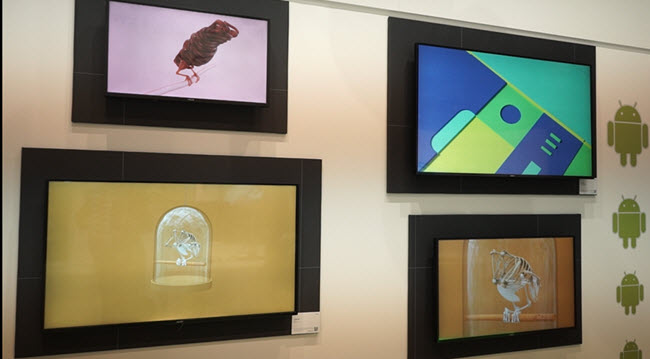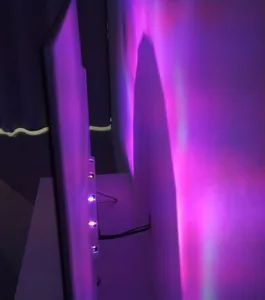Philips had a positive presence at ISE and we started by looking at a new desktop monitor. The new 275P4VYKEB is a 27″ unit with 5120 x 2880 resolution. Philips is the third vendor after HP and Dell to launch a product at this resolution. The monitor has a glare screen, as users of this kind of display like the effect, but the panel seems to have a good A/R coating, so reflections are not objectionable. The PLS panel provides 300 cd/m² of brightness and 8ms (grey to grey) response. Contrast is 1,000:1 and gamut is 99% of AdobeRGB. There are dual DisplayPort connectors (to support the highest resolution).
The 241P6VPJKEB is a 23.8″ UltraHD monitor with 99% of sRGB. Philips was also showing two FullHD USB Docking Monitors, a 21.5″ model (221S6QUMB) and a 23″ one (231P4QUPES).
The main news from Philips at the show was about a new series of digital displays, the new D-Line, which will be based on SoC technology with an Android platform. This is not a full Google Android system, but a cut down version for digital signage and that means lower hardware requirements. However, Philips told us that “We doubled everything” to ensure that existing apps could run well and Philips is very happy as “Everyone has an Android app already”.
 The new Philips D Line will support Android. Image:Meko
The new Philips D Line will support Android. Image:Meko
The SoC is a quad core device and staff told us that apps can be debugged “with a USB on a notebook”. Developers are already being recruited and supported, although the displays will not be here until Q2. There is integrated Wi-Fi and a PCI express slot that can be used to add a second Wi-Fi system to help develop “mesh” networks. A 16GB SD card can be fitted and there is 2GB of RAM. The displays have autorotation sensors and have integrated software including a Chromium browser and a media player that can show PDF format. CMS programmes can be supported using the API. Several software vendors have already signed up, including Instoremedia.
Access from the network can give remote app management and as Philips is also developing its hospitality TVs to run on the Android platform, eventually hotels and other institutions using a mixture of signage and hospitality TVs will be able to manage all of them from a single platform that Philips is calling “Dragon1”.
Sizes of the D-Line will be 32″, 43″, 49″, 55″ and 65″ and there will be ten point infrared touch options.
There will be a new 75″ added to the U-line and there will be a touch option. Philips has improved the surface on its touch glass and has better anti-glare performance as well as “anti-burn” technology for better user comfort.
Another development that will come out during 2016 is the integration of the latest AmbiLux technology into the B2B line. Unlike the Ambilight, which uses LEDs, the AmbiLux system uses LED projectors on the back of the set to create coloured patterns around the set. The technology was first shown on TVs at IFA. A feature that may be popular in the B2B space is that there is an API that can be used to create custom patterns and colours rather than simply mapping from the content on the display.

